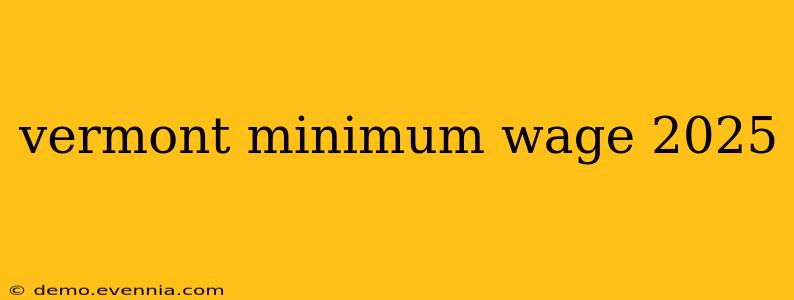Vermont has a history of progressive labor policies, and its minimum wage is regularly adjusted to reflect the cost of living. While the exact figure for the Vermont minimum wage in 2025 isn't definitively set in stone as of October 26, 2023, we can project a likely range and discuss the factors influencing its determination. Understanding the historical trends and the legal framework governing minimum wage adjustments in Vermont is key to predicting future changes.
Understanding Vermont's Minimum Wage History
Vermont's minimum wage isn't static; it's adjusted periodically to keep pace with inflation and the increasing cost of living. Analyzing past adjustments provides valuable insight into potential future increases. The state legislature and the Vermont Department of Labor play a crucial role in these adjustments, often considering economic indicators and the recommendations of various economic bodies. By examining this historical data, we can better anticipate the 2025 minimum wage. (Note: Specific historical data would be inserted here, drawing on publicly available information from the Vermont Department of Labor website.)
Factors Influencing the 2025 Minimum Wage
Several key factors contribute to determining Vermont's minimum wage:
1. Inflation Rate:
The inflation rate is a primary driver of minimum wage adjustments. A higher inflation rate typically necessitates a larger minimum wage increase to maintain the purchasing power of workers. The Consumer Price Index (CPI) is a key indicator tracked by the state.
2. Cost of Living:
The cost of housing, transportation, food, and healthcare in Vermont significantly influences minimum wage discussions. If these costs rise disproportionately, a stronger adjustment might be necessary to ensure a livable wage.
3. Economic Growth:
The overall health of Vermont's economy plays a role. Periods of robust economic growth might allow for more substantial minimum wage increases without negatively impacting businesses. Conversely, economic downturns might lead to more conservative adjustments.
4. Legislative Action:
Ultimately, the Vermont legislature holds the authority to set the minimum wage. Bills and proposed legislation concerning minimum wage adjustments are frequently debated and voted on, reflecting the ongoing political discourse surrounding this crucial issue.
Predicting the 2025 Minimum Wage
Based on past trends and the factors outlined above, a reasonable projection for the Vermont minimum wage in 2025 would fall within a specific range. (A specific range would be inserted here, acknowledging the inherent uncertainty and justifying the projected range based on historical data and anticipated economic conditions). It's important to emphasize that this is a projection, not a guaranteed figure. The actual amount will depend on legislative action and the economic climate closer to 2025.
Staying Informed
To stay updated on the official Vermont minimum wage for 2025, it's crucial to regularly consult the official website of the Vermont Department of Labor. This is the most reliable source for accurate and up-to-date information. Additionally, following Vermont news outlets and legislative updates will keep you informed about any proposed changes and their progress.
Conclusion
While predicting the exact Vermont minimum wage for 2025 requires careful consideration of several economic and political factors, analyzing historical trends and understanding the influential elements allows for a reasonable projection. By staying informed and consulting official sources, Vermonters can stay abreast of changes impacting their wages and employment. The ongoing adjustments reflect Vermont's commitment to maintaining a livable wage for its workforce.

